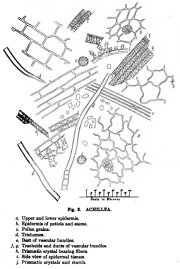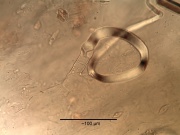Achillea millefolium (flower)
(→add category divisions) |
|||
| Line 1: | Line 1: | ||
| + | =Introduction= | ||
| + | ''Introduction from Wikipedia, the free encyclopedia (http://en.wikipedia.org/wiki/Achillea_millefolium, retrieved 02/20/2012).'' | ||
| + | |||
| + | ''Achillea millefolium'' or '''yarrow''' is a flowering plant in the family Asteraceae, native to the Northern Hemisphere. In New Mexico and southern Colorado, it is called ''plumajillo'', or "little feather", for the shape of the leaves. In antiquity, yarrow was known as ''herbal militaris'', for its use in staunching the flow of blood from wounds. Other common names for this species include common yarrow, gordaldo, nosebleed plant, old man's pepper, devil's nettle, sanguinary, milfoil, soldier's woundwort, thousand-leaf (as its binomial name affirms), and thousand-seal. | ||
| + | |||
| + | Common yarrow is an erect herbaceous perennial plant that produces one to several stems (0.2 to 1m tall) and has a rhizomatous growth form. Leaves are evenly distributed along the stem, with the leaves near the middle and bottom of the stem being the largest. The leaves have varying degrees of hairiness (pubescence). The leaves are 5–20 cm long, bipinnate or tripinnate, almost feathery, and arranged spirally on the stems. The leaves are cauline and more or less clasping. The inflorescence has 4 to 9 phyllaries and contains ray and disk flowers which are white to pink. There are generally 3 to 8 ray flowers that are ovate to round. Disk flowers range from 15 to 40. The inflorescence is produced in a flat-topped cluster. The fruits are small achenes. Yarrow grows at low or high altitudes, up to 3500m above sea level. The plant commonly flowers from May through June, and is a frequent component in butterfly gardens. Common yarrow is frequently found in the mildly disturbed soil of grasslands and open forests. Active growth occurs in the spring. | ||
| + | |||
| + | In North America, there are both native and introduced genotypes, and both diploid and polyploid plants. The plant has a strong, sweet scent, similar to chrysanthemums. | ||
| + | |||
| + | ''The quoted text in this section was licensed for use under the Creative Commons ShareAlike License, version 3.0: http://creativecommons.org/licenses/by-sa/3.0/'' | ||
| + | =Macroscopic Entries= | ||
| + | =Microscopic Entries= | ||
| + | |||
{{Microscopy | source=Schneider, A. (1921) The Microanalysis of Powdered Vegetable Drugs, 2nd ed. | {{Microscopy | source=Schneider, A. (1921) The Microanalysis of Powdered Vegetable Drugs, 2nd ed. | ||
| mainimage=Microanalysis_powdered_vegetable_p_204_google_ver_achillea.png | | mainimage=Microanalysis_powdered_vegetable_p_204_google_ver_achillea.png | ||
| Line 15: | Line 28: | ||
| characteristics=Hair cells simple with one to six basal cells and long apical cell; walls moderately thick, smooth. 400X Acidified chloral Hydrate Soln. | | characteristics=Hair cells simple with one to six basal cells and long apical cell; walls moderately thick, smooth. 400X Acidified chloral Hydrate Soln. | ||
| }} | | }} | ||
| + | |||
| + | =HPTLC Entries= | ||
| + | =Other Points of Interest= | ||
Revision as of 20:43, 20 February 2012
Contents |
Introduction
Introduction from Wikipedia, the free encyclopedia (http://en.wikipedia.org/wiki/Achillea_millefolium, retrieved 02/20/2012).
Achillea millefolium or yarrow is a flowering plant in the family Asteraceae, native to the Northern Hemisphere. In New Mexico and southern Colorado, it is called plumajillo, or "little feather", for the shape of the leaves. In antiquity, yarrow was known as herbal militaris, for its use in staunching the flow of blood from wounds. Other common names for this species include common yarrow, gordaldo, nosebleed plant, old man's pepper, devil's nettle, sanguinary, milfoil, soldier's woundwort, thousand-leaf (as its binomial name affirms), and thousand-seal.
Common yarrow is an erect herbaceous perennial plant that produces one to several stems (0.2 to 1m tall) and has a rhizomatous growth form. Leaves are evenly distributed along the stem, with the leaves near the middle and bottom of the stem being the largest. The leaves have varying degrees of hairiness (pubescence). The leaves are 5–20 cm long, bipinnate or tripinnate, almost feathery, and arranged spirally on the stems. The leaves are cauline and more or less clasping. The inflorescence has 4 to 9 phyllaries and contains ray and disk flowers which are white to pink. There are generally 3 to 8 ray flowers that are ovate to round. Disk flowers range from 15 to 40. The inflorescence is produced in a flat-topped cluster. The fruits are small achenes. Yarrow grows at low or high altitudes, up to 3500m above sea level. The plant commonly flowers from May through June, and is a frequent component in butterfly gardens. Common yarrow is frequently found in the mildly disturbed soil of grasslands and open forests. Active growth occurs in the spring.
In North America, there are both native and introduced genotypes, and both diploid and polyploid plants. The plant has a strong, sweet scent, similar to chrysanthemums.
The quoted text in this section was licensed for use under the Creative Commons ShareAlike License, version 3.0: http://creativecommons.org/licenses/by-sa/3.0/
Macroscopic Entries
Microscopic Entries
|
|
HPTLC Entries
Other Points of Interest
Cite error: <ref> tags exist, but no <references/> tag was found

